
Lansing-area teachers discuss mentoring practices during a day-long professional development in 2018.
MSU program underscores how mentoring matters for teacher and intern learning
By Lauren Knapp
Employers are often surprised by how prepared alumni from the Michigan State University Teacher Preparation Program are on their first day on the job. They say graduates are ready to make an extraordinary impact on the lives of their students.
That’s because the program is built on several elements deeply engrained in research, including courses led by renowned faculty members and an immersive yearlong teaching internship.
The internship is designed to give interns guidance and resources as they navigate through learning how to lead in a classroom. These sources of support come in many forms, including mentor teachers—in-classroom leaders who work one-on-one with interns across the yearlong experience. But, there was a catch.
“Mentor teachers wanted to help the MSU interns learn, but they weren’t sure how. Mentoring is a practice to be learned,” said Professor Randi Stanulis, who has spent 29 years researching teacher learning from various perspectives. She has examined how novices learn to teach, and how experienced teachers learn about their own practice while mentoring others.
And in many cases, Stanulis found, teachers were unsure of what it meant to be a mentor teacher. “We had left teachers alone to figure out how to mentor,” she added.
That needed to change, so she developed a new program: MATE.
The making of a mentor
Mentors as Teacher Educators (MATE) began in 2015 with funding from the Department of Teacher Education, and is based on findings from Launch into Teaching and ASSIST Beginning Teachers, two initiatives helmed by Stanulis to prepare beginning teachers, including through mentoring. MATE’s goal is to create a learning community of experienced teachers who talk, study and practice ways to become effective mentor teachers.
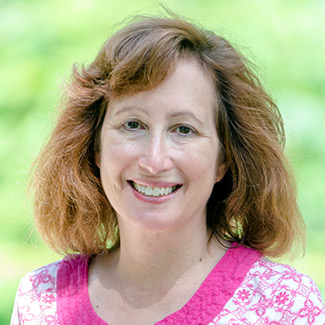
Randi Stanulis
“[Mentor teachers] wanted their role to be a defined position,” Stanulis continued. Previously, mentors received little to no preparation for their roles. “With MATE, we wanted to focus on the how and the why of teaching and mentoring.”
Through her years of research, including her doctoral dissertation at MSU, Stanulis found that mentoring should be more than just “cheerleading,” and that many mentor teachers needed more preparation to provide high-quality support. They play a critical role in a student teacher’s development, and should be prepared to be seen, and see themselves, as teacher educators.
Stanulis developed a model based on three practices:
- Co-planning – The mentor teacher and intern identify and study what students will learn, in what way and how students can demonstrate their learning.
- Observing/Debriefing – The mentor teacher targets a specific element of teaching to observe and provide feedback in a way that helps interns advance their teaching.
- Analyzing student work – The mentor helps the intern learn new ways to diagnose, notice patterns and talk about student learning grounded in standards and knowledge of standards. Student teachers also learn to articulate criteria for assignments related to standards and knowledge of student development.
These are all essential components of effective instruction in learning how to teach, Stanulis said. Mentor teachers, who are chosen based on recommendations from principals at MSU partner schools, just needed a model to help implement these practices in ways that help novices learn and improve.
The first steps
The pilot program was launched during the 2015-16 academic year with 23 mentor teachers in seven Lansing-area elementary schools. It included regular study opportunities among the mentor teachers—called mentor study groups, or MSGs—where they would learn a mentoring practice. After trying out and recording the practice in the classroom with their intern, they would write a reflection about their experience, and discuss it in the next MSG.
Sometimes I assume learning through exposure is all that is needed and in reality, I need to remember that [interns] are students, too, and need explicit teaching as well.
– Mentor teacher
Results from the pilot indicated success: 100% of respondents to a follow-up survey said they experienced a shift in how they enacted and talked about co-planning. They also had learned new ways to analyze student work and debrief with their interns.
Respondents said the program gave them “ah-ha” moments in their teaching and mentoring, and found the pilot to be “eye-opening.” They were realizing the work it took to facilitate learning and how to accommodate for interns’ learning styles.
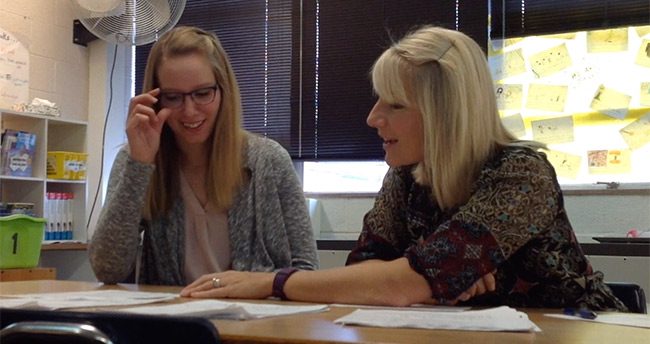
Mentor teacher and MSU alumna Tricia Zeman works with a student intern, utilizing methods learned through MATE.
In 2016-17, the program grew to include all Lansing-area elementary teachers. In 2017-18, it was expanded again to include all elementary mentor teachers in Grand Rapids partner schools and three locations in Detroit.
“The power comes from when mentors have and share feedback and ideas,” Stanulis said.
Stanulis is also sharing her expertise on learning to teach in another context: medical school. For two years, she has been director of the Office of Medical Education Research and Development (OMERAD) in the MSU College of Human Medicine.
In this role, she leads efforts to enhance physicians’ teaching practice and teacher identity. She also oversees the medical education unit to advance medical education scholarship and provide service to the college and seven medical community campuses via faculty development. After 17 years, Stanulis is no longer be a member of the College of Education faculty as of spring 2019.
Documented change
Tricia Zeman agreed the program is transformative. She was also honest about what it was like serving as a mentor teacher before the MATE program.
Zeman felt ill-informed about how to be transparent about what she was doing, how to communicate her moves or how to ensure she and her intern were co-teaching and co-planning.
“I took for granted my intern was picking up on things that I wasn’t explaining. I assumed that if they were watching me, they know what I’m doing,” said Zeman, B.S. ’00 (Child Development) and TCRT ‘02, who first joined MATE three years ago.
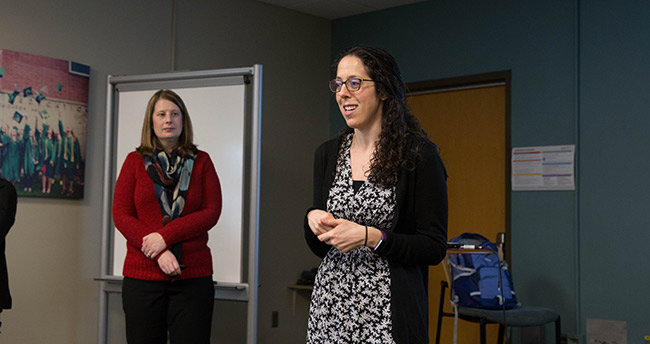
Amy Guenther (L) and Lindsay Wexler (R) welcome educators to a professional development day in Erickson Hall.
“People who are first-time mentors are appreciative of the programs and its benefits,” said Lindsay Wexler, Ph.D. ’18 (Curriculum, Instruction and Teacher Education). She was a co-researcher on a 2018 Journal of Teacher Education article about MATE’s structure and pilot program (see below).
Zeman’s “ah-ha” moment came when she realized that she was just a “teller:” saying what she was doing, but not explaining the how and why.
“Going through [MATE] before has taken me to a new level,” added Zeman, a third-grade teacher at Sycamore Elementary in Holt, Mich. “I think it’s changed my interactions with interns, my productivity and influence on them as teachers. The lessons that you learn through this program are essential and effective.”
While data showed mentors were experiencing growth in their practice and skill, Wexler’s dissertation research—exploring the program from the viewpoint of an intern—proved interns were finding value, too.
“Interns are walking away with practices that can be traced back to their mentors and the MATE program,” she said. After graduation, Wexler joined the faculty at North Central College in Illinois.
“Experienced teachers can make everything look so easy, like decision making or planning. Pre-service teachers need to learn, to see; MATE helps with that.”
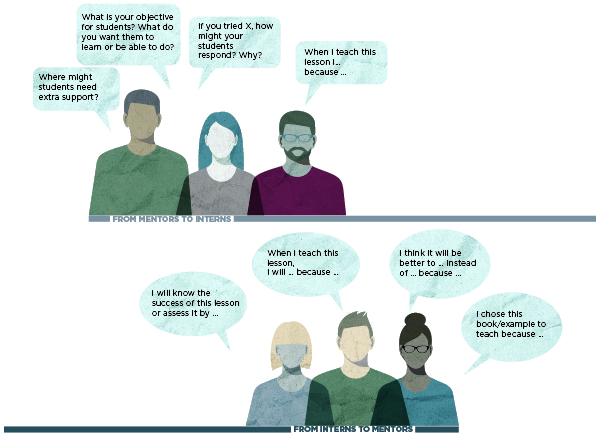
Educative Co-Planning Discussion Starters.**
A new kind of professional development
For the past several years, Wexler served as one of several MATE facilitators who coordinated MSGs and other professional development across the academic year. All facilitators have previously served as field instructors (individuals who observe and debrief with interns in their placement classrooms for the Teacher Preparation Program) and have deep connections to MSU.
- Stacey Pylman, Ph.D. ’18 (Curriculum, Instruction and Teacher Education), is an assistant professor in the College of Human Medicine, and co-led the first year of study groups with Wexler.
- Raven Jones Stanbrough, Ph.D. ’16 (CITE), is an assistant professor in the College of Education, and led the initiative in its inaugural year in southeast Michigan in 2017-18.
- Amy Guenther, Ph.D. ’19 (CITE), co-led with Wexler for two years, and now leads the program in the Lansing area.
- Amy Ward and Kim Arsenault served as the most recent leaders in the Grand Rapids area.
Guenther says it’s her history with the program that helps underline its effectiveness.
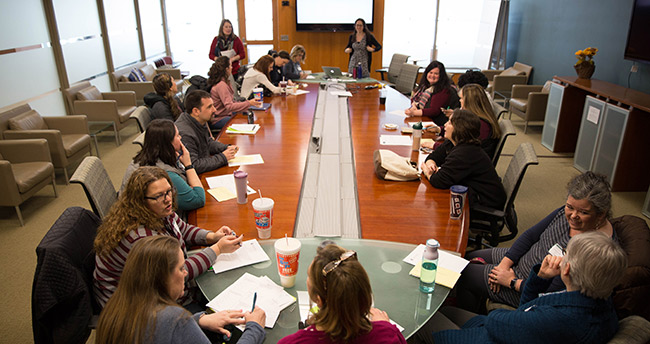
Amy Guenther and Lindsay Wexler lead a small-group session with Lansing-area mentor teachers.
“MATE is a learning opportunity for all.” she said. “Through the program, I grew as a field instructor. I grew as a teacher. I learned about professional development. So often, professional development is talking at teachers. MATE is a model where teachers talk with each other.”
Through the MSGs, Guenther continued, the goal is to help make decision-making and thinking visible to the intern.

Amy Guenther
The facilitators use principles from “educative mentoring,” a term coined by former MSU professor Sharon Feiman-Nemser, now at Brandeis University. Educative mentors take the stance of a learner while creating growth-producing experiences for an intern, including regular and critical conversations with an eye toward inquiry, introspection and continued improvement.*
In addition to frequent, small and school-based MSGs, the mentor teachers gather in a half-day professional development once per semester. The sessions feature small group discussions, ideas to take back to the classroom and keynote speakers—usually facilitators or field instructors with specialized interest areas or advice.
“These professional development days allow mentor teachers to regroup, and to get out of their buildings for immersive professional development,” said Ann Castle, who coordinates the yearlong elementary internship program and helps integrate MATE through working with field instructors. Guenther, Castle, Arsenault and Jones Stanbrough are the current co-leaders of MATE.

Raven Jones Stanbrough
The professional development days currently takes place in Lansing and in Grand Rapids, and was implemented for the first time in southeast Michigan in March 2018.
“During all the sessions for MATE, including the professional development day, I always left feeling so empowered and encouraged to work with [mentors] as we sought to better our approaches and practices for ourselves and the interns,” said Jones Stanbrough.

Ann Castle
The program continues to grow. Guenther, Castle, Jones Stanbrough and Arsenault are exploring ways in which the program can continue to scale in their respective areas and beyond.
“One message I’ve heard over and over from people who have participated in the program is to please let it continue,” Stanulis said. “My goal with MATE is to empower mentors to be principled about their work in helping interns learn how to become effective teachers.”
* Feiman-Nemser, Sharon. Teachers as teacher educators. European journal of teacher education, 21(1), 63-74.
Feiman-Nemser, Sharon. Helping novices learn to teach: Lessons from an exemplary support teacher. Journal of Teacher Education, 52(1), 17-30.
** Ideas informed by:
Feiman-Nemser, S. & Beasley, K. (1997). Mentoring as assisted performance: A case of co-planning. In V. Richardson (Ed.), Constructivist teacher education (pp. 108-126). Launch into Teaching Conversation Starters.
Pylman, S. (2016). Reflecting on talk: A mentor teacher’s gradual release in co-planning. The New Educator, 12(1), 48-66.
More research
Stanulis, Wexler, Guenther and Ward were part of a research team that published a May 2018 article in the Journal of Teacher Education: “Mentoring as More Than ‘Cheerleading’: Looking at Educative Mentoring Practices Through Mentors’ Eyes.”
https://doi.org/10.1177/0022487118773996
Pylman wrote about co-planning and mentoring for Phi Delta Kappan, a professional journal for educators, in November 2018.





